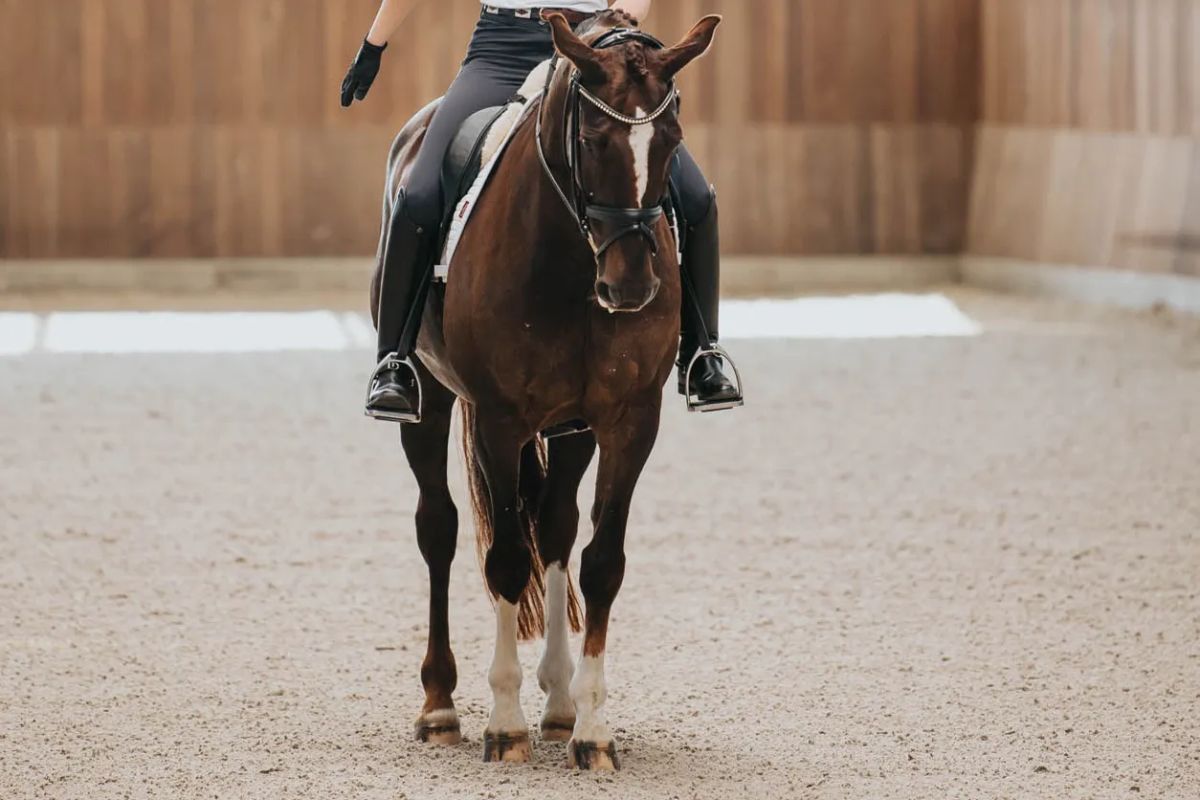Menu

Executing a (near) perfect halt is certainly no easy feat. The horse must stand squarely on all four legs and remain absolutely still directly after being in motion. Because it's 'just' about halting the horse, many underestimate how vital this exercise actually is - and that can be truly regrettable for an otherwise stunning dressage routine. The halt is one of the first things the judge sees, and its execution, therefore, provides an important first impression of you and your horse as a pair.
For some, it may happen that their halts never really become good, despite toiling away at it, training after training. Perhaps it's because they lack understanding of a small part of how the exercise is performed correctly. In other words, just minor adjustments in the way one prepares and executes their halts can make a massive difference to their quality.
To make it as easy for you as possible, we've broken down the halt and will help you step by step. That way, you can quickly find out where you need to apply effort to make it work.
Believe it or not, when you're about to ride your horse into a halt, you should ride forward. It's not at all about 'slamming on the brakes', but about catching the horse's kinetic energy so it comes up into the back and neck as it stops. Before the halt is performed, the horse should be in front of the rider's leg and kept active so that it's continuously stepping well underneath itself with its hind legs. If it doesn't do that, it will have difficulty using itself correctly when it needs to halt.
You can advantageously practice your halts from walk before moving on to doing it from trot or canter. Ride the horse forward and then engage your lower back and thighs so that the horse understands that it's not just supposed to stop, but 'sit' on its hindquarters as it halts. You should use minimal rein aid. If your horse is not accustomed to such a signal, it's just a matter of practicing it. Over time, you will hopefully be able to use less and less rein and exclusively stop the horse with your seat - and above all, maintain the energy in the transition from movement to stop.
Straightening is at once both incredibly difficult and incredibly important to be able to make a beautiful halt. In the attempt to prepare the horse that it will soon stop, one might take hold of the reins, causing the horse to 'nod' its head from side to side. Some horses might have a tendency to position themselves to one side and seek security in one rein - perhaps because they're not used to being sufficiently straightened. Here, it's - again - the rider's task to ride the horse forward and offer only the most necessary rein aid, so that the horse learns to carry itself and thus move straight. When the horse drives itself forward with its hindquarters and the rider doesn't hold it back in the rein, the straightening usually comes naturally.
Also remember, as a rider, you need to be straight in order for the horse to be. Here, you can focus on pushing down in your stirrups, sitting deeply in the saddle, and having an extended yet relaxed upper body. And above all, remember to look up and forward. This way, you show with your own body what the horse is supposed to do - and it usually goes quite well!
When you've halted your horse, it's crucial to sit absolutely still. It can be awfully tempting to correct the horse's posture or try to make it take a step forward or backward to stand more squarely. However, it's a bad idea to do anything before having full control of all the other factors for a successful halt. You risk your horse making a larger movement than desired because it's not using itself correctly or is accustomed to the aid - and that pulls down in a dressage routine. After all, it's more important that the horse stands still than its head is perfectly in front of vertical or that it stands completely square - even if that's the goal to work towards.
When you've practiced and practiced and feel that your halts are completely spot on, then you can finally start working on the horse's leg positioning. Ideally, the horse's legs should stand so parallel to each other that they form a rectangle. If you've just made an almost perfect halt, but notice that your horse isn't standing quite nicely with its legs, then you can gently correct it. For this, you only need to use your legs.
Imagine that your horse hasn't brought its right hind leg quite up to the left one - just like in the picture above. Here, you should use your own right leg to 'nudge it into place'. With your leg, you give it a little touch in the side to tell it to take a small step forward. At the same time, you have to stop it before it lifts its next leg. This requires real control, and the signals need to be tiny. Over time, your horse will certainly recognize the situation and learn to understand what you mean.
Do you reckon you can make a perfect halt now? If not, it can at least be almost perfect - and that's also a step in the right direction! Here, at least, is something to get started with, so that one day it can be achieved...
Read also
Portrait: Danish World Champion Daniel Bachmann Andersen
(Press release) New Media partnership between Schafhof Connects and Malgré Tout Media